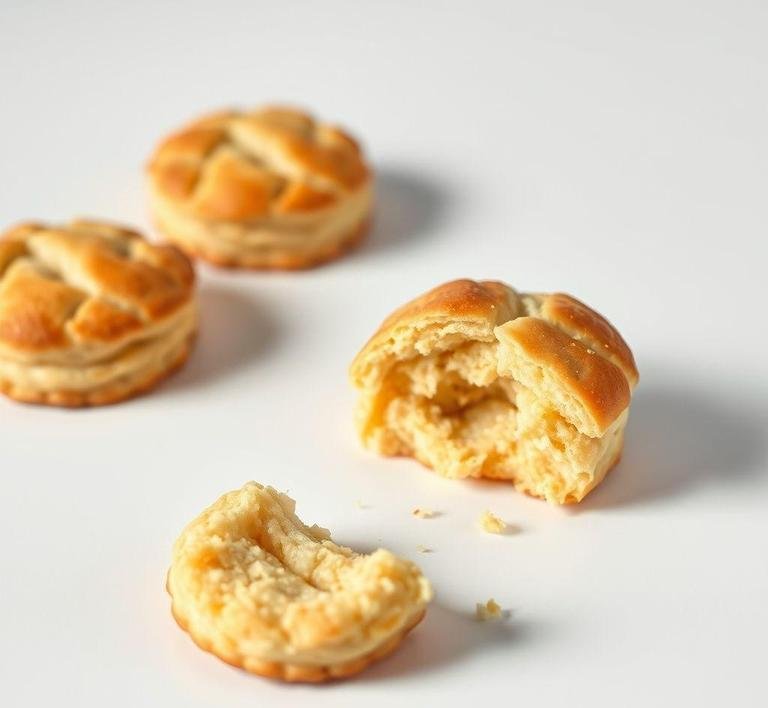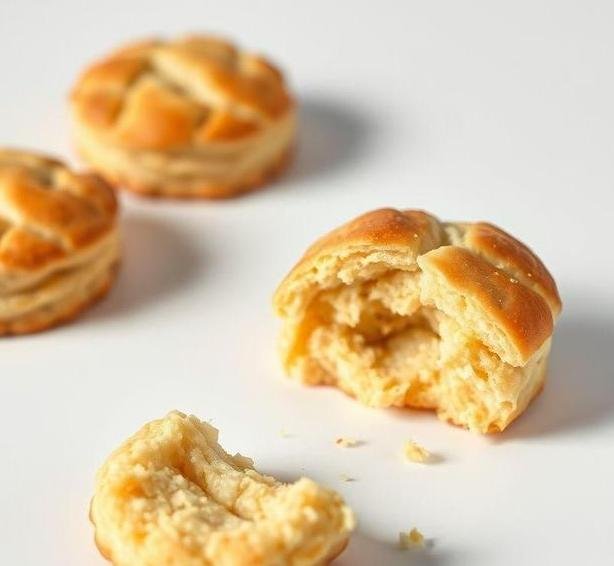Mary Berry’s Fork Biscuits are a delightful treat that perfectly captures the essence of British home baking. Known for their delicate texture and simplicity, these biscuits are famous for their characteristic appearance, created by pressing them with a fork before baking. This iconic design is not just for decoration but also contributes to the biscuits’ lovely, crisp texture. The recipe comes from the legendary Mary Berry, a staple of British cookery, who is renowned for her straightforward yet elegant baking techniques. Her fork biscuits are no exception, offering a delicious balance of butter, sugar, and a hint of vanilla that elevates any tea time.
While they are quite simple to make, fork biscuits have a timeless charm, making them a perfect addition to any afternoon tea or a lovely homemade gift for a friend or loved one. The beauty of these biscuits lies in their ability to be made with only a few common ingredients, while still managing to deliver an incredible taste and texture. It’s a recipe that feels familiar but special, providing an accessible gateway to baking for beginners and an old favorite for seasoned bakers alike.
Mary Berry’s Fork Biscuits Recipe
Ingredients Needed

Mary Berry’s Fork Biscuits require just a handful of basic ingredients, making them an easy and affordable treat to whip up. Here’s what you’ll need:
- Butter (unsalted) – 225g (about 1 cup). Butter is essential in this recipe for creating the rich, crumbly texture that defines fork biscuits. Using unsalted butter allows you to control the overall salt content in the biscuits.
- Caster Sugar – 100g (about 1/2 cup). Caster sugar is often preferred in baking because its fine grains dissolve quickly, creating a smooth dough and a soft, tender crumb. If you don’t have caster sugar, you can use granulated sugar, but the texture may be a little less smooth.
- Plain Flour – 225g (about 1 3/4 cups). Plain flour, or all-purpose flour, is the base of the dough and contributes to the biscuit’s structure. It’s important to measure your flour correctly (spoon and level method) to avoid dry or tough biscuits.
- Vanilla Extract – 1 teaspoon. A dash of vanilla adds a warm, fragrant flavor that complements the richness of the butter and the sweetness of the sugar.
- A Pinch of Salt – Optional but recommended. A pinch of salt helps balance out the sweetness and enhance the overall flavor.
- Milk (optional) – A small splash of milk can be added if the dough seems too crumbly. However, this is usually not necessary if you’ve measured your ingredients properly.
These ingredients come together to form a buttery, slightly sweet dough that’s both tender and crisp once baked. The simplicity of the recipe makes it easy to experiment with variations by adding ingredients like chocolate chips, dried fruit, or nuts if desired.
Equipment Needed
The equipment you need for Mary Berry’s Fork Biscuits is minimal, which is part of the recipe’s charm. Here’s a list of the essentials:
- Mixing Bowl – A large bowl to combine your ingredients. A sturdy one with high sides will help prevent any flour from spilling out when mixing.
- Electric Hand Mixer or Wooden Spoon – While you can mix the dough by hand, using an electric hand mixer speeds up the process and ensures a smooth dough. If you prefer a more hands-on approach, a wooden spoon will work just as well to beat the butter and sugar together.
- Baking Tray – A flat baking sheet or tray lined with baking paper or a silicone mat. This prevents the biscuits from sticking and helps them bake evenly.
- Fork – The signature tool for these biscuits! A fork is used to press down on each biscuit before baking, creating the traditional texture and pattern. It also ensures that they bake evenly by allowing the heat to penetrate the dough better.
- Measuring Cups and Spoons – For accurate ingredient quantities. Baking is an exact science, so make sure to measure your ingredients carefully.
- Cooling Rack – After the biscuits are baked, a cooling rack helps them cool evenly, allowing air to circulate and preventing them from becoming soggy.
Instructions To Make Mary Berry’s Fork Biscuits
Follow these simple yet detailed steps to make Mary Berry’s Fork Biscuits:
- Preheat the Oven – Start by preheating your oven to 180°C (160°C for fan ovens) or 350°F. This ensures that the biscuits bake evenly as soon as they go in.
- Prepare Your Baking Tray – Line a baking tray with parchment paper or a silicone baking mat to prevent the biscuits from sticking.
- Cream the Butter and Sugar – In a large mixing bowl, beat the butter and caster sugar together using an electric hand mixer or a wooden spoon. Continue mixing until the mixture becomes light and fluffy, which will take about 2-3 minutes. This step is crucial for ensuring that your biscuits turn out tender.
- Add the Flour and Salt – Gradually sift the plain flour into the butter-sugar mixture, adding a pinch of salt if desired. Use a spatula or your hands to bring the mixture together. You should have a soft dough. If it feels too crumbly, add a small splash of milk to bind it together.
- Shape the Biscuits – Take small pieces of dough and roll them into small balls, about the size of a walnut. Place them on the prepared baking tray, leaving a small gap between each one.
- Flatten with a Fork – Using a fork, gently press down on each ball of dough to flatten it slightly. You can press the fork tines both vertically and horizontally to create a criss-cross pattern, which is not only decorative but also helps the biscuits bake evenly.
- Bake the Biscuits – Place the baking tray in the preheated oven and bake the biscuits for about 12-15 minutes, or until they are lightly golden at the edges. Keep an eye on them, as baking times can vary depending on your oven.
- Cool the Biscuits – Once baked, remove the tray from the oven and allow the biscuits to cool for a few minutes on the tray. Then transfer them to a cooling rack to cool completely.
Tips And Tricks
- Room Temperature Butter – Make sure the butter is at room temperature before starting. Cold butter will be harder to mix, and the dough might not come together as smoothly.
- Chill the Dough – If the dough is too soft to handle, you can chill it in the refrigerator for about 20-30 minutes before shaping. This will make it easier to roll and press the biscuits with the fork.
- Uniform Size – For even baking, make sure the dough balls are all the same size. You can use a small cookie scoop to help with portioning the dough.
- Pressing the Fork – When you press down the biscuits with a fork, be gentle. You want to create a light indentation, not flatten them too much. If the fork gets sticky, dip it into a little flour to prevent it from sticking to the dough.
- Flavor Variations – Feel free to experiment by adding some zest (lemon or orange), spices (like cinnamon or nutmeg), or chocolate chips to the dough for a twist. Just make sure not to overload the dough with extra ingredients, as it may affect the texture.
Mary Berry’s Fork Biscuits are the epitome of simple yet satisfying baking. With minimal ingredients and straightforward instructions, they offer a perfect introduction to the world of biscuit making, while also being a beloved treat for seasoned bakers. The biscuits themselves are buttery, crumbly, and just the right amount of sweet, making them ideal for pairing with a hot cup of tea or coffee. Whether you’re baking them for a special occasion or simply as a quick treat, Mary Berry’s Fork Biscuits never fail to impress with their classic charm and irresistible flavor. So, gather your ingredients, preheat your oven, and let these golden delights fill your kitchen with the comforting aromas of home-baked goodness!
Easy Recipe Variations For Mary Berry’s Fork Biscuits

Mary Berry’s classic fork biscuits are known for their simplicity and deliciousness. However, the recipe is versatile enough to accommodate a variety of tweaks and personal preferences, allowing you to make them uniquely your own. Here are some creative and easy variations that you can try:
1. Lemon Zest Fork Biscuits
For a fresh, citrusy twist, you can incorporate lemon zest into the dough. Simply add the zest of one medium lemon along with the flour. The zest will infuse the biscuits with a subtle, refreshing flavor that pairs wonderfully with a cup of tea. If you want to elevate the lemony flavor further, you could even drizzle a thin lemon glaze over the baked biscuits once they’ve cooled.
2. Chocolate Chip Fork Biscuits
For all the chocolate lovers out there, adding chocolate chips can give Mary Berry’s fork biscuits a richer, more indulgent texture. You can either stir in dark, milk, or even white chocolate chips, depending on your preference. Just fold them into the dough after the dry ingredients have been combined, and press down with the fork to give them that signature look. These biscuits turn out wonderfully soft with pockets of gooey chocolate in every bite.
3. Vanilla And Almond Fork Biscuits
To add an extra layer of flavor, you can incorporate vanilla extract and a small splash of almond extract into the dough. This variation gives the biscuits a beautiful fragrance and a slight nutty undertone, making them perfect for a special occasion or tea party. The almond flavor, in particular, complements the buttery richness of the biscuits, creating a harmonious balance of flavors.
4. Spiced Fork Biscuits
For a warming, autumnal version, try adding ground cinnamon, nutmeg, and ginger to the flour. A teaspoon of ground cinnamon, half a teaspoon of nutmeg, and a pinch of ground ginger can transform these fork biscuits into cozy, spiced treats perfect for the fall and winter seasons. You can even sprinkle a little cinnamon sugar on top before baking for an extra touch of sweetness.
5. Coconut Fork Biscuits
For those who enjoy tropical flavors, try mixing desiccated coconut into the dough. About 50g of desiccated coconut can be added to the dry ingredients to create a subtle coconut flavor. This variation makes the biscuits a bit chewier while still maintaining the soft texture typical of Mary Berry’s fork biscuits. The coconut adds a touch of sweetness, making it a great addition to your baking repertoire.
6. Fruit And Nut Fork Biscuits
If you like a more complex flavor profile, adding dried fruit and nuts can take these biscuits to the next level. Consider folding in chopped dried apricots, cranberries, or raisins along with a handful of chopped walnuts or pecans. The fruit adds a slight tartness while the nuts provide a satisfying crunch. This is a great way to add texture and flavor while still keeping the classic biscuit texture intact.
7. Herb And Cheese Fork Biscuits
For a savory spin on Mary Berry’s sweet biscuits, you can use a combination of herbs and cheese. Try mixing grated cheddar cheese with finely chopped rosemary or thyme, adding these ingredients to the dough along with a pinch of salt and pepper. These savory fork biscuits work wonderfully as a side dish for soups or served with a charcuterie board. The cheese creates a slight crispness on the edges, while the herbs give them a fragrant, savory aroma.
Storing Leftovers
Mary Berry’s fork biscuits are at their best when fresh, but they also store remarkably well for later enjoyment. Proper storage is key to maintaining their soft, melt-in-the-mouth texture, and following a few simple guidelines will ensure your biscuits stay delicious for days.
1. Room Temperature Storage
If you plan to consume the biscuits within 3-4 days, storing them at room temperature is the most straightforward method. Place the biscuits in an airtight container or tin with a sheet of parchment paper between layers to prevent them from sticking together. The container should be kept in a cool, dry place, away from direct sunlight. This method helps preserve the freshness of the biscuits while keeping them soft and moist.
2. Freezing Leftovers
If you want to store the biscuits for a longer period, freezing them is an excellent option. Allow the biscuits to cool completely, then arrange them in a single layer on a baking sheet. Freeze for about an hour or until solid. Once frozen, transfer the biscuits into a freezer-safe bag or airtight container, separating layers with parchment paper. This method prevents the biscuits from sticking together, allowing you to pull out just a few at a time when needed. To defrost, simply leave them at room temperature for about 20 minutes, or pop them in the microwave for a quick reheat.
3. Reheating Tips
If you’re reheating fork biscuits that have been stored in the fridge or freezer, a quick blast in the oven or microwave will revive their softness. Preheat your oven to 160°C (320°F), place the biscuits on a baking tray, and heat for 5-8 minutes, or until warmed through. If using a microwave, heat them in short bursts of 10-15 seconds, checking regularly to avoid over-heating and drying them out.
What To Eat With Mary Berry’s Fork Biscuits?
Mary Berry’s fork biscuits are incredibly versatile, making them the perfect accompaniment to a variety of meals, beverages, and occasions. Whether you’re enjoying them for breakfast, afternoon tea, or dessert, these biscuits can complement a wide array of flavors.
1. Tea And Coffee
The classic pairing with these biscuits is a hot beverage, particularly tea. Whether it’s a strong Earl Grey, a delicate Darjeeling, or a more herbal blend, the buttery richness of the fork biscuits complements the light bitterness of tea perfectly. Similarly, a cup of freshly brewed coffee works beautifully with these biscuits, particularly if you’ve opted for the chocolate or nut variations.
2. Jam And Clotted Cream
A timeless British combination, fork biscuits pair wonderfully with a dollop of strawberry or raspberry jam, and a generous spoonful of clotted cream. The sweetness of the jam and the richness of the cream balance out the light, crumbly texture of the biscuits. This pairing makes for a delightful afternoon tea treat, especially when served alongside finger sandwiches and other baked goods.
3. Cheese And Fruit
For a savory twist, pair your fork biscuits with a selection of cheeses-cheddar, brie, or goat cheese work well-and fresh fruits like grapes, figs, or apple slices. The slight saltiness of the cheese and the sweetness of the fruit create a beautiful contrast with the biscuits’ texture. This is also an ideal option for a light lunch or evening appetizer, especially when entertaining guests.
4. Fresh Berries Or Custard
If you’re serving Mary Berry’s fork biscuits as part of a dessert, consider pairing them with fresh berries such as raspberries, strawberries, or blueberries. Their natural sweetness and acidity can enhance the flavor of the biscuits. Alternatively, serve the biscuits with a bowl of velvety custard or a scoop of vanilla ice cream for a comforting dessert experience.
5. Soup And Stews
If you’ve made a savory variation of fork biscuits, they make a fantastic accompaniment to hearty soups and stews. The light, buttery texture complements the richness of a vegetable soup, a creamy tomato bisque, or a meat-based stew. Their soft yet slightly crisp texture makes them perfect for dipping into your favorite soup or stew.
Conclusion
Mary Berry’s fork biscuits are a timeless treat, loved for their simplicity, buttery flavor, and delightful texture. With their versatile nature, they can be easily customized with a variety of flavors, from citrus zest to rich chocolate, making them suitable for any occasion, whether it’s a casual afternoon snack or a celebratory dessert. Storing leftovers is easy, and with a few simple tricks, you can enjoy these biscuits well beyond their initial baking. Pair them with your favorite beverages, jams, or cheeses for an even more enjoyable experience. Whether you stick with the classic version or explore creative variations, these biscuits are sure to bring comfort and joy to your kitchen.
FAQs
What Are Mary Berry’s Fork Biscuits?
Mary Berry’s fork biscuits are a classic, simple biscuit recipe known for their light, crumbly texture. Made with basic ingredients like butter, sugar, flour, and an egg, these biscuits are shaped by pressing them with a fork before baking. The fork gives them a beautiful, textured finish while ensuring they bake evenly.
Can I Use Margarine Instead Of Butter In Mary Berry’s Fork Biscuits Recipe?
Yes, you can use margarine instead of butter in Mary Berry’s fork biscuits recipe. However, butter typically provides a richer flavor and a more delicate texture, while margarine may result in a slightly firmer biscuit. If you prefer a dairy-free option, margarine can work well as a substitute.
How Can I Make Mary Berry’s Fork Biscuits Softer?
To make Mary Berry’s fork biscuits softer, you can try adding a little more butter or reducing the baking time slightly. Also, ensure not to overwork the dough when mixing, as this can lead to tougher biscuits. If you want extra softness, you can incorporate a small amount of cornflour (cornstarch) into the flour mix.


